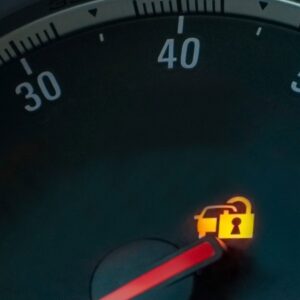The immobilizer system in the vehicle doesn’t have a distinct appearance, as it is made of electrical components, such as wires connected to the vehicle’s electronic control unit. Immobilizers are comprised of two systems: the parts inside the vehicle and those that make up the key fob or remote. The part in the vehicle can be a standalone module, built into the body computer, the instrument cluster, or the PCM.
Typically, there is a coil around where the key is inserted that activates when the key is switched on, and it triggers the chip in the key to output a digital code that is supposed to match one of the codes the system has been programmed to accept. If the code isn’t received or the wrong code is sent from the key, the theft light will typically blink rapidly and the vehicle will either spin and not start, start and die, or it won’t even spin the starter.

Fobs and remotes are typically attached to your vehicle key. Transponders that correlate with the immobilizer are found in these devices, allowing them to transmit a code that either activates or deactivates the immobilizer.
Note that “Immobilizer” is a common term used by many but not all automakers to describe the OEM system designed to prevent people without a programmed key from taking the vehicle.
- Ford: Uses the Passive Anti-Theft System (PATS), also known as SecuriLock®.
- Volkswagen: Implements an electronic immobilizer in its vehicles.
- Toyota: Features an engine immobilizer system in many models.
- Honda: Uses an immobilizer system that prevents unauthorized engine starts.
- BMW & Mercedes-Benz: Have advanced electronic immobilizers integrated into their security systems.
- GM calls their system Passlock, PassKey, PassKey II, and PassKey III, all of which are variations of GM’s transponder-based security systems.
- Chrysler may refer to their system as immobilizer or Passive Anti-Theft Systems (PATS)
The Importance of a Car Immobilizer
An immobilizer is an anti-theft device that restricts the operation of your vehicle, only allowing its engine to start if it receives the correct code from the car key. This means nobody can drive off with your vehicle unless they have the key, greatly reducing the risk of your car getting hot-wired.
When the correct key is transmitted from the key fob to the immobilizer, anti-theft measures are disabled, allowing the engine to start.
Any information provided on this Website is for informational purposes only and is not intended to replace consultation with a professional mechanic. The accuracy and timeliness of the information may change from the time of publication.
































